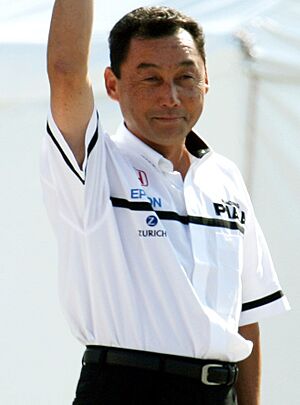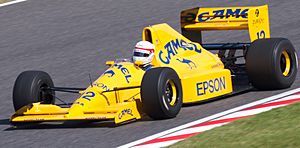Satoru Nakajima facts for kids
Quick facts for kids
Satoru Nakajima
|
|
|---|---|
| 中嶋 悟 | |

Nakajima in 2008
|
|
| Born | 23 February 1953 Okazaki, Aichi, Japan
|
| Children |
|
| Formula One World Championship career | |
| Nationality | |
| Active years | 1987–1991 |
| Teams | Lotus, Tyrrell |
| Entries | 80 (74 starts) |
| Championships | 0 |
| Wins | 0 |
| Podiums | 0 |
| Career points | 16 |
| Pole positions | 0 |
| Fastest laps | 1 |
| First entry | 1987 Brazilian Grand Prix |
| Last entry | 1991 Australian Grand Prix |
| Previous series | |
|
|
| Championship titles | |
| 1981–1982, 1984–1986 |
Japanese Formula Two |
Satoru Nakajima (Japanese: 中嶋 悟, Hepburn: Nakajima Satoru, born 23 February 1953) is a Japanese former racing driver and a leader in motorsport. He raced in Formula One from 1987 to 1991.
Born in Okazaki, Aichi, Japan, Nakajima started his racing journey at the Suzuka Circuit in 1973. He became a top driver in Japanese Formula Two, winning five championships and 21 races between 1981 and 1986. After racing in other series like sportscar racing and International Formula 3000, Nakajima joined Lotus in 1987. He became the first Japanese driver to race full-time in Formula One at the Brazilian Grand Prix Grand Prix. He scored his first points in the next race in San Marino and finished a career-best fourth at the British Grand Prix Grand Prix.
During his time at Lotus, Nakajima scored points at the 1988 Brazilian and 1989 Australian Grands Prix. In Australia, he set the fastest lap and finished fourth. Nakajima moved to Tyrrell in 1990, earning points in the United States, Italy, and Japanese Grands Prix. He stayed with Tyrrell for his 1991 season, racing with Honda engines. He scored his final points at the first race of the season, the United States Grand Prix Grand Prix. After this, he left to help Honda develop a new Formula One car. Nakajima tested the RC100 and other models until 1994, when Honda stopped their Formula One project.
After retiring from racing, Nakajima focused on his Nakajima Racing team. He had started this team in 1984 to race March cars in the Japanese Formula Two Championship. His team won three championships in a row until 1986. Nakajima Racing won four Formula Nippon Teams' Championship titles between 1999 and 2009. His team still races in the Super Formula Championship and the Super GT Series today. Nakajima's sons, Kazuki and Daisuke, also became racing drivers. Kazuki raced in Formula One for Williams from 2007 to 2009.
Contents
Early Life and First Races
Satoru Nakajima was born on February 23, 1953, into a farming family near Okazaki, Aichi, Japan. He started driving cars as a young teenager in his family's garden. His older brother gave him tips, making sure their father did not see them. He loved the feeling of driving a car and knew from then on what he wanted to do.
Nakajima began racing after finishing school and getting his driver's license. In 1973, he was a new driver in the Suzuka Circuit series, which he won. Five years later, he won his first race in Japanese Formula Two. In 1981, he won his first championship, starting a period where he was the best driver in the series. He won five of the next six championships, all with a Honda V6 engine.
Formula One Career
Nakajima took part in 80 Formula One Grand Prix races. His first race was the 1987 Brazilian Grand Prix on April 12, 1987. He brought Honda engines to the Lotus team. He was 34 years old when he started, making him one of the older new drivers in modern Formula One. He finished sixth in only his second race, the 1987 San Marino Grand Prix, earning a point. During his first season, his teammate Ayrton Senna was much faster. Many people wondered if Nakajima was in F1 only because of Honda's support.
Honda had wanted Nakajima to join Williams for the 1986 season. Honda supplied engines to Williams at that time. However, Williams owner Frank Williams did not want to replace Nigel Mansell. Mansell had won his first two races at the end of the 1985 season. Frank Williams believed that having Mansell and two-time World Champion Nelson Piquet would give his team the best chance to win the Constructors' title. He thought Nakajima, who was new to F1, would struggle. Lotus was looking for a new engine partner for 1987 because Renault was leaving the sport. Lotus agreed to take Nakajima as part of their new engine deal with Honda. He replaced Johnny Dumfries in the second car.

The 1988 season was difficult for both Nakajima and Lotus. It was the last season for turbo engines. Nakajima's car used the same Honda V6 engines that helped McLaren drivers Senna and Alain Prost win 15 of the 16 races that year. Nakajima scored only one point, finishing sixth in the first race in Brazil. He also failed to qualify his Lotus 100T car at Monaco and Detroit. These were the only times a Honda V6 turbo engine failed to qualify for a Grand Prix between 1983 and 1988. Despite this, Nakajima sometimes pushed his teammate, the reigning World Champion Nelson Piquet.
Nakajima was not always the best at qualifying or racing, even with powerful Honda V6 turbo engines like McLaren's. However, at the 1988 Japanese Grand Prix at Suzuka, he showed great strength. Just 30 minutes before Friday practice, he learned his mother had passed away. Despite this, he matched his famous teammate's qualifying time exactly on Saturday. Piquet and Nakajima qualified 5th and 6th. Nakajima was actually faster than the three-time World Champion on Friday. This effort earned the Japanese driver new fans and much praise in the F1 world.
Lotus showed faith in Nakajima by re-signing him for 1989, even after Honda announced they would not supply engines to the team after 1988. Nakajima and his teammate Piquet then drove the Judd V8 powered Lotus 101. Nakajima continued to wear Honda patches on his racing suit even when he did not drive for a Honda-powered team. The season had its ups and downs. Both drivers failed to qualify for the 1989 Belgian Grand Prix. This was the first time in 30 years that Lotus had failed to make the race grid. A highlight for Nakajima in 1989 was a fourth-place finish and fastest lap in the rainy Australian Grand Prix. This was his only points finish that year and matched his best career result from the 1987 British Grand Prix. Nakajima's race in Adelaide was impressive. He was last after a spin on the first lap but finished only 4.648 seconds behind the third-placed Williams-Renault car. Even critics like BBC commentator and 1976 World Champion James Hunt praised him.
Nakajima joined Tyrrell for the 1990 season. The team also promised to use Honda V10 engines in 1991. He raced for Tyrrell for two quiet years at the back of the field before ending his career. In 1990, his teammate was young Frenchman Jean Alesi, who scored 13 points (including two second places) compared to Nakajima's three. In 1991, with Honda engines used by McLaren in 1990, his teammate was Italian Stefano Modena. Modena outscored Nakajima again, with 10 points to Nakajima's two. Nakajima's points came from finishing fifth in the first race of the season in Phoenix.
Honda left Formula One a year later to start building their own team. The car, the Honda RC100, was shown to the media in February 1993, driven by Nakajima. It passed crash tests, meaning Honda could enter their team into F1. To make their car better, Honda built two more, the RC101 and 101B. The 101B was for racing. Nakajima had the first public test of the 101B in Suzuka in January 1994. Honda decided not to enter their own cars in F1 at that time. Instead, they chose to develop their engines in America for CART and later the IRL.
Life After Racing
Nakajima still lives in his family home near Okazaki. He owns the Nakajima Racing team, which competes in Japanese Formula 3000 / Formula Nippon / Super Formula. Nakajima Racing drivers have won the Formula Nippon championship three times: Tom Coronel in 1999, Toranosuke Takagi in 2000, and Ralph Firman in 2002.
Nakajima's son, Kazuki, raced for the Williams team in Formula One in the 2008 and 2009 seasons. Nakajima's younger son, Daisuke, is also a racing driver. He competed in the British Formula 3 Championship in 2009 and 2010. After their open-wheel racing careers, both sons moved to sports car racing. Kazuki raced in the FIA World Endurance Championship with Toyota Gazoo Racing, and Daisuke raced in Super GT. Both have since retired from racing. Kazuki retired after the 2021 FIA World Endurance Championship to take on a management role with Toyota Gazoo Racing. Daisuke retired at the end of the 2019 Super GT Series and has kept a low profile since.
Helmet Design
Nakajima's helmet was white with two red lines that formed a circle shape on the chin area. There was a wide line on the back of the helmet with "NAKAJIMA" written on it. His son Kazuki Nakajima uses a slightly different version of this helmet design.
Video Games
Between 1988 and 1994, Nakajima supported many Formula One video games for different game systems like Family Computer, Sega Mega Drive, Game Boy, and Super Famicom. Most of these games were only released in Japan. However, one game Nakajima supported for the Mega Drive was released worldwide as Ferrari Grand Prix Challenge. He also appeared as a playable driver in his Lotus 100T in Codemasters' F1 2013.
Images for kids
See also
 In Spanish: Satoru Nakajima para niños
In Spanish: Satoru Nakajima para niños



